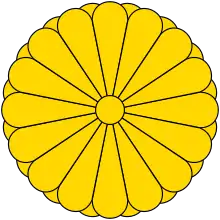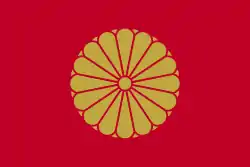Emperor Ankō
Emperor Ankō (安康天皇, Ankō-tennō) was the 20th legendary Emperor of Japan,[2] according to the traditional order of succession.[3] Emperor Ankō is the earliest generally agreed upon historical ruler of all or a part of Japan.[4]
| Ankō | |||||
|---|---|---|---|---|---|
 Picture of Ankō | |||||
| Emperor of Japan | |||||
| Reign | 453–456 (traditional)[1] | ||||
| Predecessor | Ingyō | ||||
| Successor | Yūryaku | ||||
| Born | Anaho (穴穂) 401 Japan | ||||
| Died | 24 September 456 (aged 54–55) Japan | ||||
| Burial | Sugawara no Fushimi no nishi misasagi (菅原伏見西陵) (Nara) | ||||
| Spouse | Empress Nakashi | ||||
| Issue | See below | ||||
| |||||
| House | Imperial House of Japan | ||||
| Father | Emperor Ingyō | ||||
| Mother | Empress Oshisaka no Ōnakatsuhime | ||||
| Religion | Shinto | ||||
No firm dates can be assigned to this Emperor's life or reign, but he is conventionally considered to have reigned from 453 to 456.[5]
Legendary narrative
Ankō was a 5th-century monarch and the first generally agreed upon historical ruler of Japan.[4] The reign of Emperor Kinmei (c. 509 – 571 AD), the 29th Emperor,[6] is the first for which contemporary historiography is able to assign verifiable dates;[7] however, the conventionally accepted names and dates of the early Emperors were not to be confirmed as "traditional" until the reign of Emperor Kanmu (737–806), the 50th sovereign of the Yamato dynasty.[8]
According to Kojiki and Nihon Shoki, Ankō was the second son of Emperor Ingyō, his birth name was Anaho (穴穂皇子). His elder brother Prince Kinashi no Karu was the Crown prince, but due to an incestuous relationship with his sister, Karu no Ōiratsume, Kinashikaru lost favour with the court. After an aborted attempt to rally troops against Ankō, Kinashi no Karu (and his sister-lover) were exiled and committed suicide.
Ankō's contemporary title would not have been tennō, as most historians believe this title was not introduced until the reign of Emperor Tenmu. Rather, it was presumably Sumeramikoto or Amenoshita Shiroshimesu Ōkimi (治天下大王), meaning "the great king who rules all under heaven". Alternatively, Ankō might have been referred to as ヤマト大王/大君 or the "Great King of Yamato".
Ankō was assassinated in his third year of reign by Mayowa no Ōkimi (Prince Mayowa), in retaliation for the execution of Mayowa's father.[9]
The actual site of Ankō's grave is not known.[2] The Emperor is traditionally venerated at a memorial Shinto shrine at Nara Prefecture.
The Imperial Household Agency designates this location as Ankō's mausoleum. It is formally named Sugawara no Fushimi no nishi misasagi.[10]
His Empress was Princess Nakashi (中磯皇女), Emperor Richu’s daughter. He did not have other consorts and any children.
Consorts and children
Empress: Princess Nakashi (中磯皇女), Emperor Richu's daughter
Gallery
 Memorial Shinto shrine and mausoleum honoring Emperor Ankō
Memorial Shinto shrine and mausoleum honoring Emperor Ankō
Ancestry
| Ancestors of Emperor Ankō | |||||||||||||||||||||||||||||||||||||||||||||||||||||||||||||||||||||||||||||||||||||||||||||||||||||||||||||||||||||||||||||||||||||||||||||||||||||||||||||||||||||||||||||||||||||||||||||||||||||||||||||||||||||||||||||||||||||||||||||||||||||||||||||||||||||||||||||||||||||||||||||||||||||||||||||||||||||||||||||||||||||||||||||||||||||||||||||||||||||||||||||||||||||||||||||||||||||||||||||||||||||||||||||||||||||||||||||||||||||||||||||||||||||||||||||||||||||||||||||||||||||||||||||||||||||||||||||||||||||||||||||||||||||||||||||
|---|---|---|---|---|---|---|---|---|---|---|---|---|---|---|---|---|---|---|---|---|---|---|---|---|---|---|---|---|---|---|---|---|---|---|---|---|---|---|---|---|---|---|---|---|---|---|---|---|---|---|---|---|---|---|---|---|---|---|---|---|---|---|---|---|---|---|---|---|---|---|---|---|---|---|---|---|---|---|---|---|---|---|---|---|---|---|---|---|---|---|---|---|---|---|---|---|---|---|---|---|---|---|---|---|---|---|---|---|---|---|---|---|---|---|---|---|---|---|---|---|---|---|---|---|---|---|---|---|---|---|---|---|---|---|---|---|---|---|---|---|---|---|---|---|---|---|---|---|---|---|---|---|---|---|---|---|---|---|---|---|---|---|---|---|---|---|---|---|---|---|---|---|---|---|---|---|---|---|---|---|---|---|---|---|---|---|---|---|---|---|---|---|---|---|---|---|---|---|---|---|---|---|---|---|---|---|---|---|---|---|---|---|---|---|---|---|---|---|---|---|---|---|---|---|---|---|---|---|---|---|---|---|---|---|---|---|---|---|---|---|---|---|---|---|---|---|---|---|---|---|---|---|---|---|---|---|---|---|---|---|---|---|---|---|---|---|---|---|---|---|---|---|---|---|---|---|---|---|---|---|---|---|---|---|---|---|---|---|---|---|---|---|---|---|---|---|---|---|---|---|---|---|---|---|---|---|---|---|---|---|---|---|---|---|---|---|---|---|---|---|---|---|---|---|---|---|---|---|---|---|---|---|---|---|---|---|---|---|---|---|---|---|---|---|---|---|---|---|---|---|---|---|---|---|---|---|---|---|---|---|---|---|---|---|---|---|---|---|---|---|---|---|---|---|---|---|---|---|---|---|---|---|---|---|---|---|---|---|---|---|---|---|---|---|---|---|---|---|---|---|---|---|---|---|---|---|---|---|---|---|---|---|---|---|---|---|---|---|---|---|---|---|---|---|---|---|---|---|---|---|---|---|---|---|---|---|---|---|---|---|---|---|---|---|---|---|---|---|---|---|---|---|---|---|---|---|---|---|---|---|---|---|---|---|---|---|---|---|---|---|---|---|---|---|---|---|---|---|---|---|---|---|---|---|---|---|---|---|---|---|---|---|---|---|---|---|---|---|---|---|---|---|---|---|---|---|---|---|---|---|---|---|---|---|---|---|---|---|---|---|---|---|---|---|---|---|---|---|---|---|---|---|---|---|---|---|---|---|---|---|---|
| |||||||||||||||||||||||||||||||||||||||||||||||||||||||||||||||||||||||||||||||||||||||||||||||||||||||||||||||||||||||||||||||||||||||||||||||||||||||||||||||||||||||||||||||||||||||||||||||||||||||||||||||||||||||||||||||||||||||||||||||||||||||||||||||||||||||||||||||||||||||||||||||||||||||||||||||||||||||||||||||||||||||||||||||||||||||||||||||||||||||||||||||||||||||||||||||||||||||||||||||||||||||||||||||||||||||||||||||||||||||||||||||||||||||||||||||||||||||||||||||||||||||||||||||||||||||||||||||||||||||||||||||||||||||||||||
See also
Notes

- "Genealogy of the Emperors of Japan" at Kunaicho.go.jp; retrieved 2013-8-28.
- Imperial Household Agency (Kunaichō): 安康天皇 (20); retrieved 2013-8-28.
- Titsingh, Isaac. (1834). Annales des empereurs du japon, pp. 26–27; Brown, Delmer M. (1979). Gukanshō, p. 258; Varley, H. Paul. (1980). Jinnō Shōtōki, p. 113.
- Kelly, Charles F. "Kofun Culture", Japanese Archaeology. 27 April 2009.
- Ponsonby-Fane, Richard. (1959). The Imperial House of Japan, p. 40.
- Titsingh, pp. 34–36; Brown, pp. 261–262; Varley, pp. 123–124.
- Hoye, Timothy. (1999). Japanese Politics: Fixed and Floating Worlds, p. 78; excerpt, "According to legend, the first Japanese Emperor was Jinmu. Along with the next 13 Emperors, Jinmu is not considered an actual, historical figure. Historically verifiable Emperors of Japan date from the early sixth century with Kinmei.
- Aston, William. (1896). Nihongi, pp. 109.
- Aston, William. (1998). Nihongi, Vol. 1, pp. 328–333.
- Ponsonby-Fane, p. 419.
- "Genealogy". Reichsarchiv (in Japanese). Retrieved 9 January 2021.
References
- Aston, William George. (1896). Nihongi: Chronicles of Japan from the Earliest Times to A.D. 697. London: Kegan Paul, Trench, Trubner. OCLC 448337491
- Brown, Delmer M. and Ichirō Ishida, eds. (1979). Gukanshō: The Future and the Past. Berkeley: University of California Press. ISBN 978-0-520-03460-0; OCLC 251325323
- Ponsonby-Fane, Richard Arthur Brabazon. (1959). The Imperial House of Japan. Kyoto: Ponsonby Memorial Society. OCLC 194887
- Titsingh, Isaac. (1834). Nihon Ōdai Ichiran; ou, Annales des empereurs du Japon. Paris: Royal Asiatic Society, Oriental Translation Fund of Great Britain and Ireland. OCLC 5850691
- Varley, H. Paul. (1980). Jinnō Shōtōki: A Chronicle of Gods and Sovereigns. New York: Columbia University Press. ISBN 978-0-231-04940-5; OCLC 59145842
| Regnal titles | ||
|---|---|---|
| Preceded by Emperor Ingyō |
Emperor of Japan: Ankō 453–456 (traditional dates) |
Succeeded by Emperor Yūryaku |
